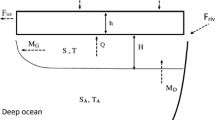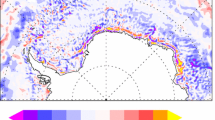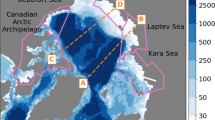Abstract
A simple climate model has been developed to investigate the existence of the small ice cap instability in the Southern Hemisphere. The model consists of four coupled components: an atmospheric energy balance model, a thermodynamic snow-sea ice model, an oceanic mixed layer model and a terrestrial ice model. Results from a series of experiments involving different degrees of coupling in the model show that the instability appears only in those cases when an explicit representation of the Antarctic ice sheet is not included in the model. In order to determine which physical processes in the ice sheet model lead to a stabilization of the system we have conducted several sensitivity experiments in each of which a given ice sheet process has been removed from the control formulation of the model. Results from these experiments suggest that the feedback between the elevation of the ice sheet and the snow accumulation-ice ablation balance is responsible for the disappearance of the small ice cap instability in our simulation. In the model, the mass balance of the ice sheet depends on the air temperature at sea level corrected for altitude and it is, therefore, a function of surface elevation. This altitude-mass balance feedback effectively decouples the location of the ice edge from any specific sea level isotherm, thus decreasing the model sensitivity to the albedo-temperature feedback, which is responsible for the appearance of the instability. It is also shown that the elevation-radiative cooling feedback tends to stabilize the ice sheet, although its effect does not seem to be strong enough to remove the instability. Another interesting result is that for those simulations which include the terrestrial ice model with elevation-dependent surface mass balance, hysteresis is exhibited, where for a given level of external forcing, two stable solutions with different, non-zero ice-sheet volume and area and different air and ocean temperature fields occur. However, no unstable transition between the two solutions is ever observed. Our results suggest that the small ice cap instability mechanism could be unsuitable for explaining the inception of glaciation in Antarctica.
Similar content being viewed by others
Author information
Authors and Affiliations
Additional information
Received: 14 April 1997 / Accepted: 22 October 1997
Rights and permissions
About this article
Cite this article
Morales Maqueda, M., Willmott, A., Bamber, J. et al. An investigation of the small ice cap instability in the Southern Hemisphere with a coupled atmosphere-sea ice-ocean-terrestrial ice model. Climate Dynamics 14, 329–352 (1998). https://doi.org/10.1007/s003820050227
Issue Date:
DOI: https://doi.org/10.1007/s003820050227




